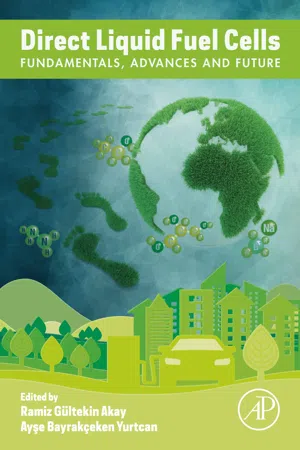
Direct Liquid Fuel Cells
Fundamentals, Advances and Future
- 328 pages
- English
- ePUB (mobile friendly)
- Available on iOS & Android
Direct Liquid Fuel Cells
Fundamentals, Advances and Future
About This Book
Direct Liquid Fuel Cells is a comprehensive overview of the fundamentals and specificities of the use of methanol, ethanol, glycerol, formic acid and formate, dimethyl ether, borohydride, hydrazine and other promising liquid fuels in fuel cells. Each chapter covers a different liquid fuel-based fuel cell such as: Anode catalysts of direct methanol fuel cells (DMFCs), future system designs and future trends for direct ethanol fuel cells (DEFCs), development of catalysts for direct glycerol fuel cells (DGFCs), the mechanisms of the reactions taking place at the anode and cathode electrodes, and the reported anode catalysts for direct formic acid fuel cell (DFAFC) and direct formate fuel cell (DFFC), characteristics of direct dimethyl ether fuel cell (DDMEFC), including its electrochemical and operating systems and design, the developments in direct borohydride fuel cells, the development of catalysts for direct hydrazine fuel cells (DHFCs), and also the uncommonly used liquids that have a potential for fuel cell applications including 2-propanol, ethylene glycol, ascorbic acid and ascorbate studied in the literature as well as utilization of some blended fuels. In each part, the most recent literature is reviewed and the state of the art is presented. It also includes examples of practical problems with solutions and a summarized comparison of performance, advantages, and limitations of each type of fuel cell discussed. Direct Liquid Fuel Cells is not a typical textbook but rather designed as a reference book of which any level of students (undergraduate or graduate), instructors, field specialists, industry and general audience, who benefit from current and complete understanding of the many aspects involved in the development and operation of these types of fuel cells, could make use of any chapter when necessary.
- Presents information on different types of direct liquid fuel cells.
- Explores information under each section, for specific fuel-based fuel cells in more detail in terms of the materials used.
- Covers three main sections: direct alcohol, organic fuel-based and inorganic fuel-based fuel cells
Frequently asked questions
Information
Chapter 1: Introduction to fuel cells
b Faculty of Engineering, Chemical Engineering Department, Kocaeli University, Kocaeli, Turkey
c Atombir Energy Technologies Laboratory Chemistry Informatics Software Automation Contact Electric Electronic Limited Company, Middle East Technical University Technocity, Ankara, Turkey
d Nanoscience and Nanoengineering Research and Application Center, Atatürk University, Erzurum, Turkey
* Corresponding author
Abstract
Keywords
1.1: A brief history of the development of fuel cell (FC) technology

Table of contents
- Cover image
- Title page
- Table of Contents
- Copyright
- Contributors
- Preface
- Chapter 1: Introduction to fuel cells
- Chapter 2: Introduction to direct alcohol fuel cells (DAFCs)
- Chapter 3: Direct methanol fuel cells (DMFCs)
- Chapter 4: Direct ethanol fuel cells (DEFCs)
- Chapter 5: Direct glycerol fuel cells (DGFCs)
- Chapter 6: Introduction to other organic fuel-based fuel cells
- Chapter 7: Direct formic acid and formate fuel cells (DF(A)FCs)
- Chapter 8: Direct dimethyl ether fuel cells (DDMEFCs)
- Chapter 9: Introduction to inorganic fuel-based direct liquid fuel cells
- Chapter 10: Direct borohydride fuel cells (DBFCs)
- Chapter 11: Direct hydrazine fuel cells (DHFCs)
- Chapter 12: Other possible fuels and possible use of blended fuels in fuel cells
- Chapter 13: Conclusions: Current state and future
- Index